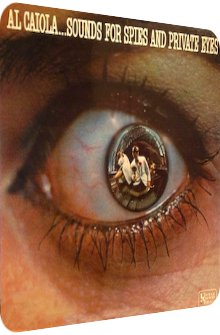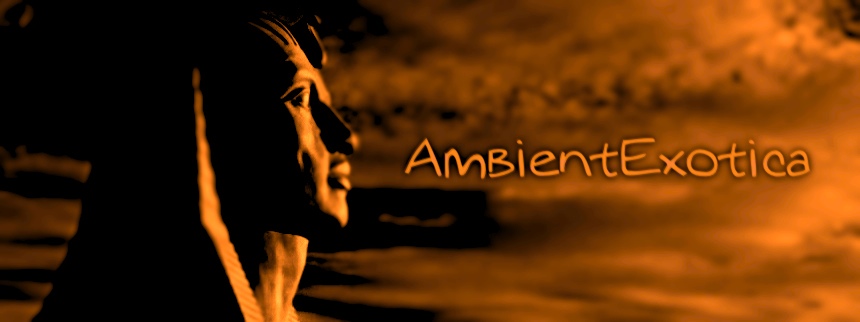
Al Caiola
Sounds For Spies
And Private Eyes
1965
The guitar is not enough, there's a whole world to conquer
Sounds For Spies And Private Eyes is a Crime Jazz album of 12 tracks envisioned and realized by famed guitarist Al Caiola (born 1920), released during the genre peak in 1965 on United Artists Records. Eleven of its compositions are actually renditions of famous movie themes about certain special agents, their secret operations and many a climactic affair in-between, a trait it shares with genre mica such as Enoch Light's most unique and cherished release The Private Life Of A Private Eye (1959) or Chaquito's late Spies And Dolls (1972). It is certainly true that Caiola's stringed signature instruments is most applicable in these surroundings of enigmas, dangerous rides and plot twists, but surprisingly enough, the guitarist refrains from being the nucleus of this undertaking and is rather briefed himself by a large ensemble of brass players, bongo and timbale drummers, organists and mallet instrumentalists. The result is therefore rather dense and immediate, creating a cocktail of immersive layers that is eldritch, jazzy, playful, recondite, remote and turbulently sunny over the course of this album. The moods may change, but the cutting edge of spy-related tone sequences and brute force endeavors is always a given. Here is a closer look at the moods, constituents and principal forces in this dangerous game.
The guitarist…
Naturally, Al Caiola plays it cool in this release, especially so since the material is appropriate enough for a rather cool approach that is evoked in the opener Theme From "The Man From U.N.C.L.E." by Jerry Goldsmith. It is more of a joyful carnival with diaphanous constituents than a truly pumping action scene, but the guitar itself is slick, abrasive and Surf Rock-oriented. It is almost a pity that Caiola is surrounded by so many instruments – among them a hot-like-lava Hammond organ and tropical marimbas – whose amicable aura asphyxiate the darker edge of the licks. But the guitarist tries to cope with the situation throughout the album, be it on P.F. Sloan's and Steve Barri's Secret Agent Man which sees the guitarist spawn saltatory twangs of a slightly Oriental mischievous-hatched twilight or The Third Man Theme by Anton Karas which rightfully puts the guitar into the spotlight where it replaces the half-jocund zither with a raspier granuloma. And let's not forget Al Caiola's own rhythm-shifting Bronze Doll where the writer willfully degrades himself as a rhythm guitarist, making room for muted brass layers en mase.
… and his big band
When all is said and done – and currently, there's still a lot to say regardless – it becomes clear that the big band is the actual center of attention, what with the angular viewpoint being fueled by a wealth of lounge instruments and scything horns that tower above the arrangement like an evil villain in his high-rise hideout looking down onto the city that is about to be eliminated due to his evil plan. Michael Carr's Man Of Mystery would be such an instance where the studio personnel outshines Al Caiola with everything they have to offer: from a hectic bongo punctilio to organ-accompanied polyphonous trombones, everyone involved dreams big in this Spy Jazz corker. Marian Grudeff's and Raymond Jessel's Baker Street Mystery offers yet another brass-centric mystery to crack, with organ arabesques, incisive timbale coppices and Saturday-past-midnight spectacles on the brazen side of life. There's trumpets everywhere, and no one intends to stop until the runtime is truly over. But the ensemble can evoke a pre-Disco sentiment as well: Pete Rugolo's The Fugitive Theme is unexpectedly warm, almost entirely sunset-colored and benignant. It is here where the darker solanum-seeding magnetotails of Al Caiola seem to prosper due to the aura of salubrious light.
The Glamour Factor while danger's in the air
Sounds For Spies And Private Eyes is one epitome of a sunny/shadowy dualism, with Al Caiola usually serving as the darker, seemingly mean-spirited opponent to the big band's blazing charm and vitreous amalgamations. The instrumental pool serves the cinematic edge, spy-focused photometry and sense of adventure, and granted, Al Caiola wants to radiate all of these characteristic traits as well, but no can do, he is but one highly talented guitarist in-between many musicians who are equally skilled in putting their signature instrument to the best of use. Caiola doesn't want to be the nucleus on this album, but marketing reasons and the spy craze of the mid-60's are two reasons to promise things the guitarist cannot fulfill all by himself. This is good news for Crime Jazz fans and Exotica buffs alike, as they are allowed to bask in multinucleate surroundings in an advantageous setting. From mephitic clandestinity over smoke-filled action sequences to the jolliest of all settings that doesn't want to hurt no one in an overall string of events that is less based on Latin timbres than one might imagine, Sounds For Spies And Private Eyes is a great and successful, one that is grandiloquent, immersive and coherent enough to feature in a remastered state. Available on vinyl, streaming services and a dedicated download version.
Exotica Review 447: Al Caiola – Sounds For Spies And Private Eyes (1965). Originally published on Aug. 22, 2015 at AmbientExotica.com.
